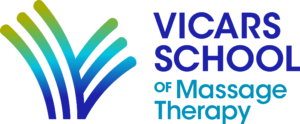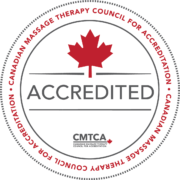Adding Infant Massage To Your RMT Practice: In conversation with a Vicars grad
This is the second instalment in a series about pediatric massage: massage therapy for children ranging from infants to adolescents. Check out the first post to learn about massage therapy for infants, including its potential benefits for both parents and child and the science that assesses those benefits. Today’s post is a conversation with an experienced Vicars graduate who has incorporated infant massage into her practice.
Shannon Collum, RMT, is a Vicars graduate who lives and works in Duncan, BC. She owns Maple Bay Massage Therapy there. As part of her general therapeutic practice, Shannon also has training in infant massage education, and offers one-on-one and group sessions with parents and their babies.

Shannon Collum, RMT
I recently talked to Shannon about this part of her practice.
Robin: Can you give me a brief overview of your experience with infant massage?
Shannon:
Early in my career, I found I was working with a lot of pregnant clients. It just happened by word of mouth—I think it helped that a lot of my friends were at the right age to start having babies!
As I went on, I realized I wanted to offer even more services in this area. We had learned the fundamentals of infant massage in school, but I knew there was more to learn.
I found a continuing education course for RMTs on infant massage and at the same time I trained as a doula, learning how to give support to mothers during and after childbirth. I was fascinated by it and knew there were at least some of my clients who would be interested.
I’ve been a massage therapist for more than 18 years now. Teaching infant massage has been a bigger part of my practice at some points than others. But it’s something I enjoy and that I’m glad I can offer to my clients.
There are so many different continuing education options out there for massage therapists—so many different directions and areas of practice for people to choose from. Would you recommend taking infant massage, and pregnancy massage?
When new grads ask me for continuing ed recommendations, I always say that it depends on what resonates with you. What are you interested in? Because if you’re not really engaged with whatever it is, you’re not going to make a success of it.
For me, I’ve always had a connection with babies and children—it’s always been a part of my life. If an RMT feels the same way, furthering your education by taking ongoing training in pregnancy massage and training new parents may be a good choice for you.
And you have to be practical too, of course. Think about the focus of your practice, where you work, and your current and potential clientele. If you’re based in more a retirement community this will obviously be less of a focus in your practice!
How do you introduce the idea of infant massage to pregnant clients?
I have it listed on my website as something I have experience in, and so some of my clients bring it up to me themselves or even find me that way. But usually it will organically come up in a conversation with them about what they’re experiencing, their hopes or even what they’re nervous about.
The last time it came up was I was working on a woman who was quite far along in her pregnancy. I was performing abdominal massage, and I was explaining to her how we do the strokes in a specific direction around the abdomen to promote digestion. I explained that this is also what we do with babies, and she says, “Wait, we can do massage on babies?!?!”
Do you find that do you usually get that surprised reaction? In your experience, do parents know that this is an option?
Some do, some don’t. And some are confused—some think that I do the massage; that they bring the baby into the clinic. But I explain that it involves teaching the parents what to do and how to do it in a way that is comfortable, safe, and joyful. And for most people, I find, that’s a lot more appealing.
So how do these sessions work?
I like to set up a class, either one-on-one or in a group setting, outside the clinic. It’s usually a set of four short sessions. That way, baby isn’t overwhelmed by a new environment and the parents are able to practice with the child between sessions. My goal with these sessions is for the babies and the parents to feel relaxed and have fun together, and for the parents to leave feeling confident and excited about having learned a new way to connect with their baby.
I normally don’t teach the classes for babies younger than two months. Before that, massage can be overwhelming and too stimulating. Babies still don’t understand the world, and they are getting bombarded with new information every second, so we wait until they’re a little more settled.
Earlier, you were telling me about a recent client you had for infant massage that was a bit of an exception to this rule. Can you share that story?
Of course. That experience was exceptional in a few ways: it was only one session, it was at my clinic, her baby was a newborn, and we fit it in after I had just given the mother a full massage!
This woman was living and working in a very small community up north on Vancouver Island. Because of the remoteness and lack of medical care, her employer transferred her down here to Duncan for a month or so before her due date, and for a couple of weeks to recover postpartum. She booked a few prenatal massages for herself while she was in town. Because I saw her regularly for a few weeks, we developed a rapport and had lots of conversations about her pregnancy and upcoming baby, and we ended up talking about infant massage in a general sort of way.
Not long after she gave birth, she came in for a last massage before heading home. She then revealed that the doctor had told them their baby had significant torticollis and she wondered if I could help. They weren’t going to be in town long enough for that, and baby needed some specific help as soon as possible, so we arranged for baby and dad to arrive at the end of her next appointment. I ended up working with them for about 15 minutes in the treatment room, laying baby on the warm massage table in front of us. I demonstrated a few techniques specifically for that issue and had them try them out and walked them through a few other things. I was able to start the process of improving his positioning and they felt more confident taking him back up north without an RMT nearby. Everybody was happy.
What sticks out to me about this story is that this was a therapeutic massage, essentially. I usually think of infant massage as being about helping the baby sleep better, helping with bonding, helping with digestion…
But when you think about it, babies have just gone through a quite physically demanding experience! Especially in that case, as he was very newly born. But even after that, they’re constantly building muscles that have never been used before.
But you’re right, a lot of times people don’t realize that something like torticollis can happen to babies. Extreme versions don’t happen a lot. Usually, it’s mild and corrects itself over time. But in this case, it was extreme, and he wasn’t able to keep his head straight.
The infant massage outcome that is probably most well known is how it strengthens bonding between parents and baby, helps babies sleep, and can help with things like colic and digestive issues. What people don’t always think about is that it can help alleviate postnatal depression for both parents. It seems most effective when massage is built into their daily routine. For infants, massage sessions should be short but frequent; a little quiet time after baby’s bath is great.
But there can be more direct physical benefits, too. I remind parents that birth is hard for babies too. As newborns, they’re not moving much and they’re often end up facing in one direction for long periods in car seats, carriers, and strollers. It’s a tough life!
And, of course, as babies get bigger they turn into active children, and children’s bodies are going through a lot, too. Starting massage at a young age can really help as they age and start getting growing pains and other bumps and bruises. Because they’re starting life with more body awareness, they’re more likely to be able to communicate about what is happening in their bodies when they need help.
Thank you so much for taking the time to share your experience with infant massage! Is there anything else you’d like to add?
I almost forgot to mention, although it is really important to me, is that learning how to give a massage to your baby or child can actually help them start to understand bodily autonomy, consent, and the concept of healthy touch. Those are big concepts, but understanding them starts with day-to-day routines like this.
One of the things that we teach parents is to make sure that they’re only massaging when baby consents. This is more nebulous when they’re very young and you’re just starting out, but you start to learn your baby’s body language. You can tell when they’re up for it and when they’re not. And when they’re not, you just hang out with them so they’re still getting one-on-one time and see that their refusal doesn’t equal rejection from their loved one.
It’s showing kids, from a young age, that they have a say in what happens to their body. And that’s a really huge thing, in my opinion.


